This thread will be to show results of different full lab analysis done by using MALDI-MASS and amino acid analysis to determine if large peptides such as IGF LR3 and IGF DES really are being produced and sold by different peptide companies. This started by me personally testing Great White Peptides LR3 and finding that it was GHRP instead due to the severe hunger side effects and then when testing on fasting early am caused a significant rise to serum GH in blood tests which only can happen from GHRP and not any type of IGF. IGF of any sort will and have no effect on serum GH levels. This lead to wanting to do extensive testing on everybody's products.
Several companies and members on PM donated funds and products to be tested. Maxim Peptides, Extreme, Purchase Peptides and Ergo were all willing and all donated funds for the cost of the testing to be done at a major university protein & chemistry lab. Every one of these companies donated funds and samples to be tested. Two companies that did not participate on their own but got their LR3 tested by donation of other members were Ostagain and SRC.
Osta particularly had a problem because they though somehow i would favor only Ergo due to me helping Phil cut through some of the BS some suppliers were giving him and trying to clean up his line up. SRC's LR3 was also tested but the company was not involved in the testing.
I have have said over and over again that my reputation and dignity means more than anything. There is nothing a peptide company can offer me to change my views on the truth. I told every sponsor that i will post exactly what is given to me by the lab and that there will be no sugar coating at all.
The testing was done by Texas A&M Protein and Chemistry lab and they are one of the premier labs for testing peptides in this country. I suggest you guys read the thread "Demand more from your sponsors" to understand the testing methods used.
Extreme Peptide LR3
To explain how to read each i am going to get a little nerdy. IGF LR3 has a mass weight of 9111 daltons. Assuming we could get a 100% pure peptide that was exactly we should get a very tall and narrow peak right at 9111 area. You can see from the MALDI-MASS that we have a very nice peak at the 9111 area but there is also another peak at the 9400 area. This is approximately a 3 amino acid difference in weight. You can see two smaller peaks in the 4000 range but small enough that really not a big deal. The sample is obviously not 100% pure LR3. The good new is that we do have a lot of protein at the 9111 area. So that is the MS.
Now the XL worksheet you see is the AAA (amino acid analysis) this is where the sample is actually broken down and we can see how many of each amino acid is present in a single chain. For example how many glutamine, how many leucine or valine etc. Since we know how many of each are SUPPOSED TO be in a real LR3 we can compare the PERCENTAGE of each known amino acid to be there vs what we actually get from sample tested. This is where it really things matter. That is because i can make a peptide long enough that weighs close to 9111 daltons and get a mass spec graph but it can be pure crap and have nothing to even do with IGF LR3. Hope this makes sense.
We can see from the XL worksheet that the sample was ran in a tripplicate assay for even better accuracy and the number of nanomoles of each amino acid in the chain.
Column C shows number of each amino acid that is supposed to be in a real LR3
Column D shows % of weight of each amino acid that is supposed to be in a real LR3
Column E shows % of weight of each amino acid that we actually got from sample being tested in this case Extreme's LR3
You can see that predicted vs what we got is very close and told by lab director completely within range of lab error and they include a 1.5% up or down either direction completely acceptable. So we can see that the Extremes sample had the right amount of each amino acid in the chain.
If you look at C:43 you can see that there was 989 micrograms of protein in total in the vial which means 0.98 mg which is 98% of 1mg. There was some Histidine amino acids in a very small amount found which LR3 should have no Histidine and lab director explained that this is most likely Histidine that is left over from the tagging process that may have not been cleaved off but extremely small which also is the cause of the 2nd spike we see on the MS graph at 9400 area.
Overall he felt very comfortable to say this is LR3 Enjoy
Enjoy
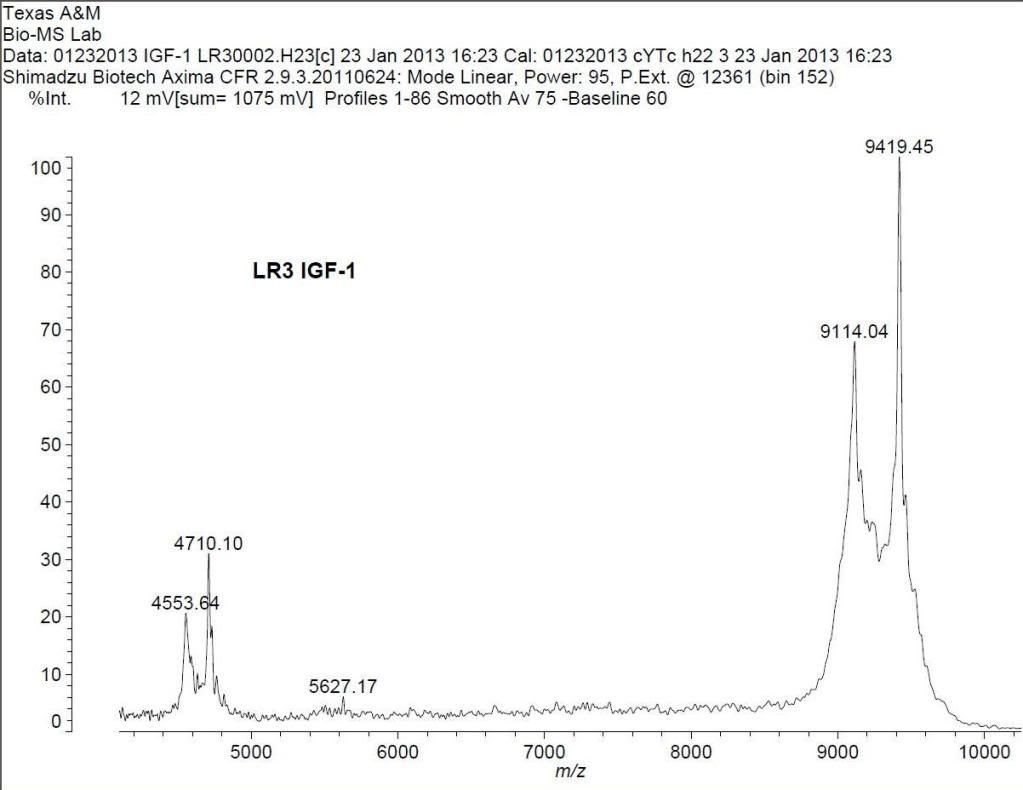
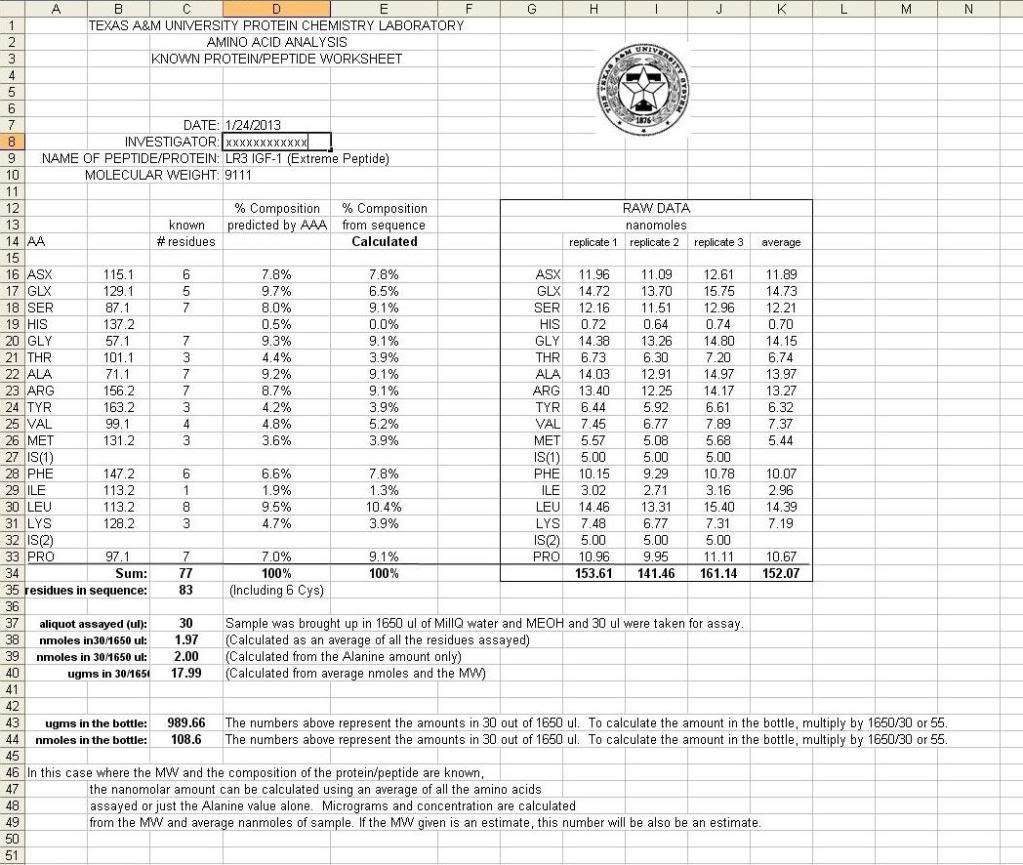
Ostagain, SRC, Maxim LR3
Analysis for Maxim, Osta and SRC were done and results posted on same spec sheet for direct comparison. And i can say that they all look pretty good. Some better than others but i will go thru that detail in a little bit. The Mass Spec on all three appear on a single sheet. Let me give everybody some further clarification on Mass Spec. This is not a quantitative test meaning the height of the curve means NOTHING as far as how much product is there. So if a peak is higher than another does not mean that there is more of that compound than one that has a smaller or taller peak. Hope that makes sense. Mass spec allows you to find how PURE your compound is and if there are other proteins with different target weights in the same sample.
All four LR3 tested have small peak in the 4500 range area. That is EXPECTED. MALDI TOF measures particles in single charged particles and since our target weight is 9111 daltons some couples charged particles will show up 9100/2= ~4500 range. The key factor is that if you had and could make a 100% pure LR3 you would have a single tall peak at 9111 and nothing else. We see that with SRC. There are no peaks anywhere else below or above 9111. With Osta's LR3 we see peaks 7000,9100 and 9400 range. The 9400 rang peak is similar to same 9400 peak as in Maxim (even though it looks taller it is meaningless) and Extreme that we tested last week. This is for sure from Histidine that was uncleaved in the final process. The % appears very small because the amino acid analysis looks good on all samples. The only issue that Ostas LR3 had that none of the other 3 had was that there was a peak at 7000. That is a compound that is not IGF-1, DES or LR3. So it is either degraded LR3 that has broken down to smaller weights but it is a little unlikely cause then we should have peaks in other places besides 7000. Maxim's mass spec looked very good same as Extreme we did last week. It has a nice peak at 9100 area and a tiny peak at 9400 due to histidine being attached that shows up in the amino acid analysis.
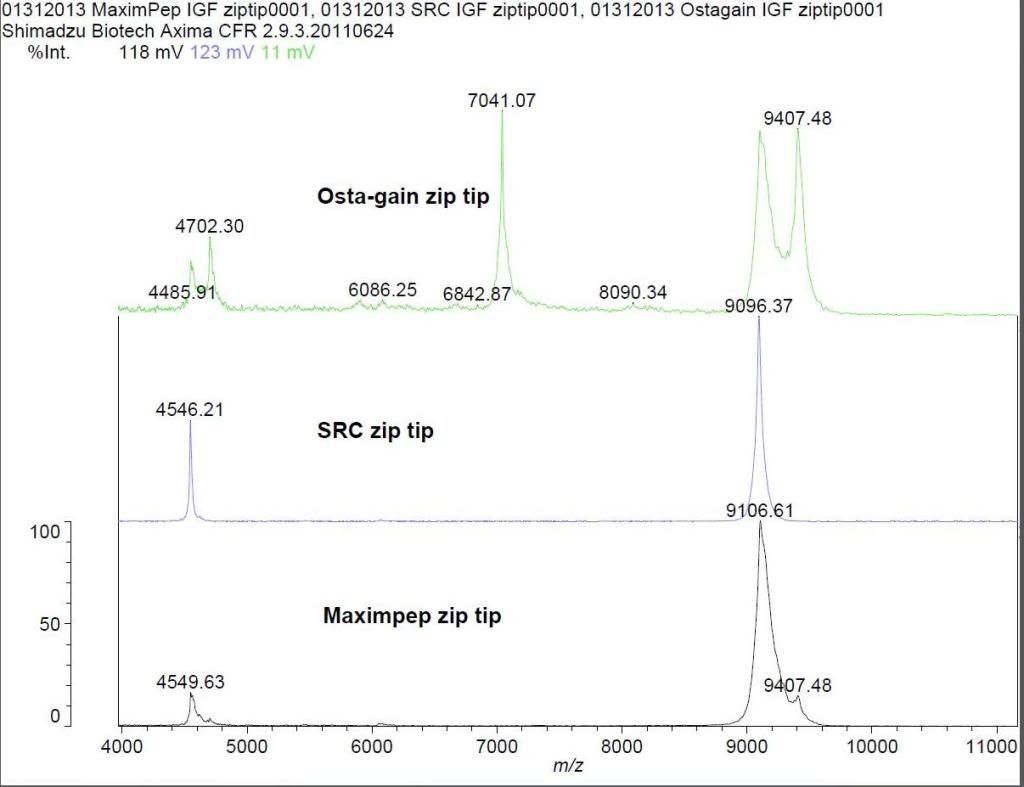
Now this is SRC's AAA: The percentages of each amino acid is within range and overall looks very good. This was the only sample that had 0.0% histidine. The only issue was that there was only approximately 0.8mg of product which is 20% short of advertised amount.
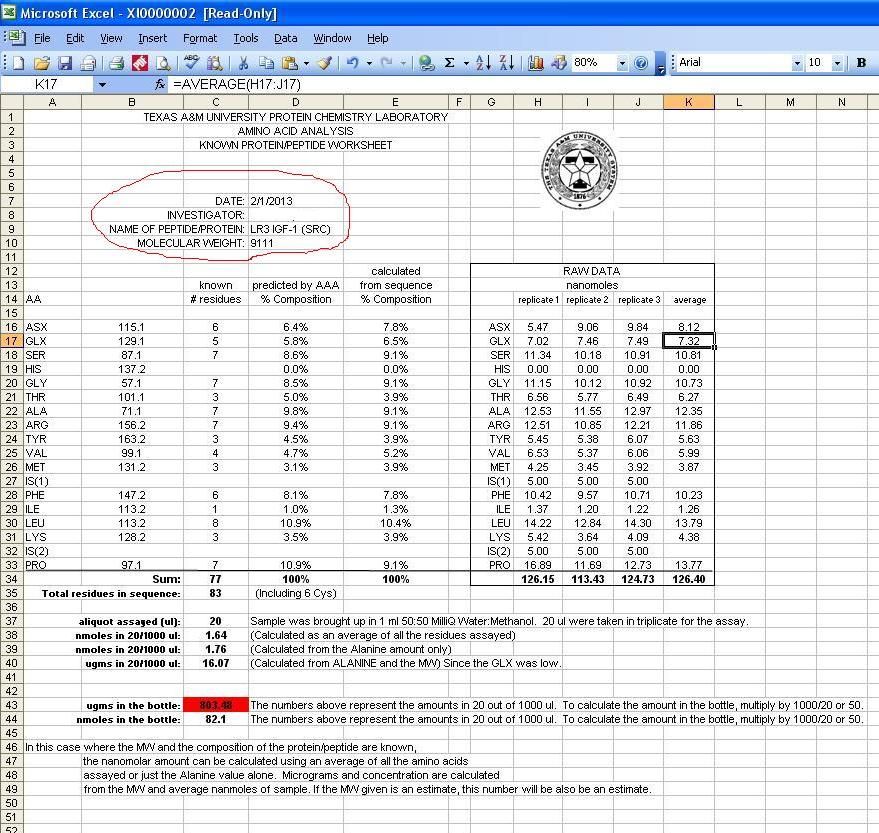
This is Osta's AAA. The amino acid percentages look spot on and had minor histidine like all the others. The only issue was that it had approx 0.73mg of total protein in the vial.
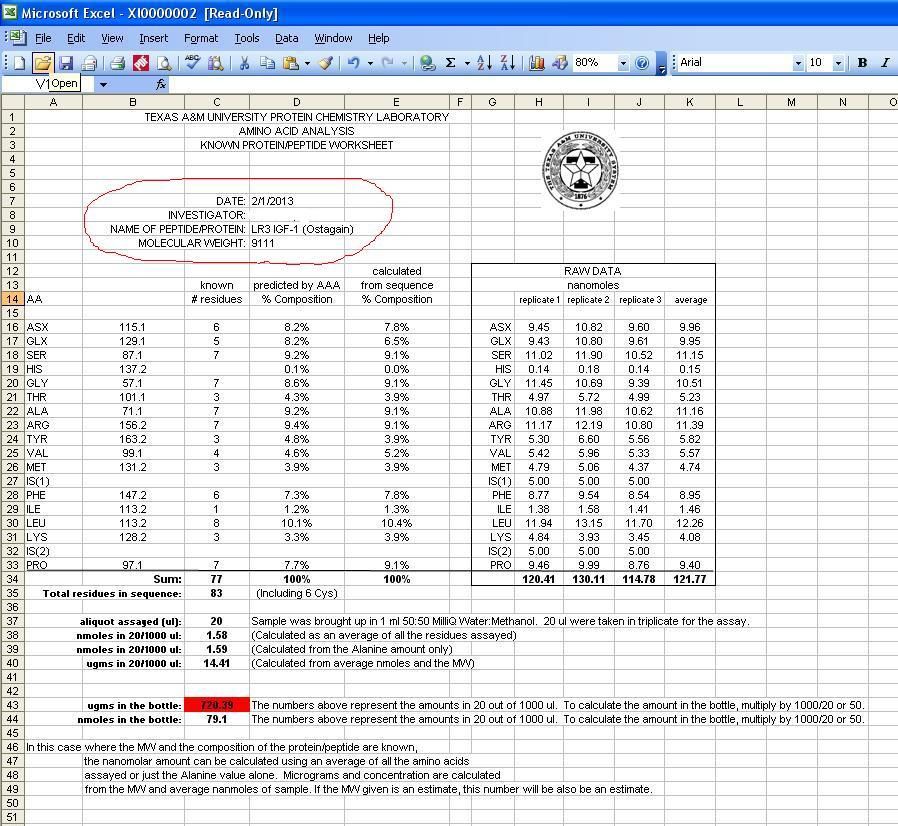
This is Maxim's AAA. It also looked very good with minimal Histidine attached and has 0.95mg of total protein attached. Both the Extreme and Maxim LR3 in analysis looked pretty identical. Phil mentioned under the IGF thread yesterday that his source is exact same and it is good to get confirmation through the lab on how close they were after MassSpec and amino acid analysis.

Purchase Peptides LR3
The results are nearly identical to Extreme, Maxim, and Ergo USA LR3. I would rate these 4 LR3 as excellent LR3. You can see in the mass spec that we have a nice tall peak at 9100 range with a tiny bump in the 9400 range which again is because of the tiny amount of histidine tag present. The rest of the mass spec looks very clean without any other impurities. The amino acid analysis also looks very good with total of 0.95mg of total LR3 in the vial which is pretty as much as good as it gets.
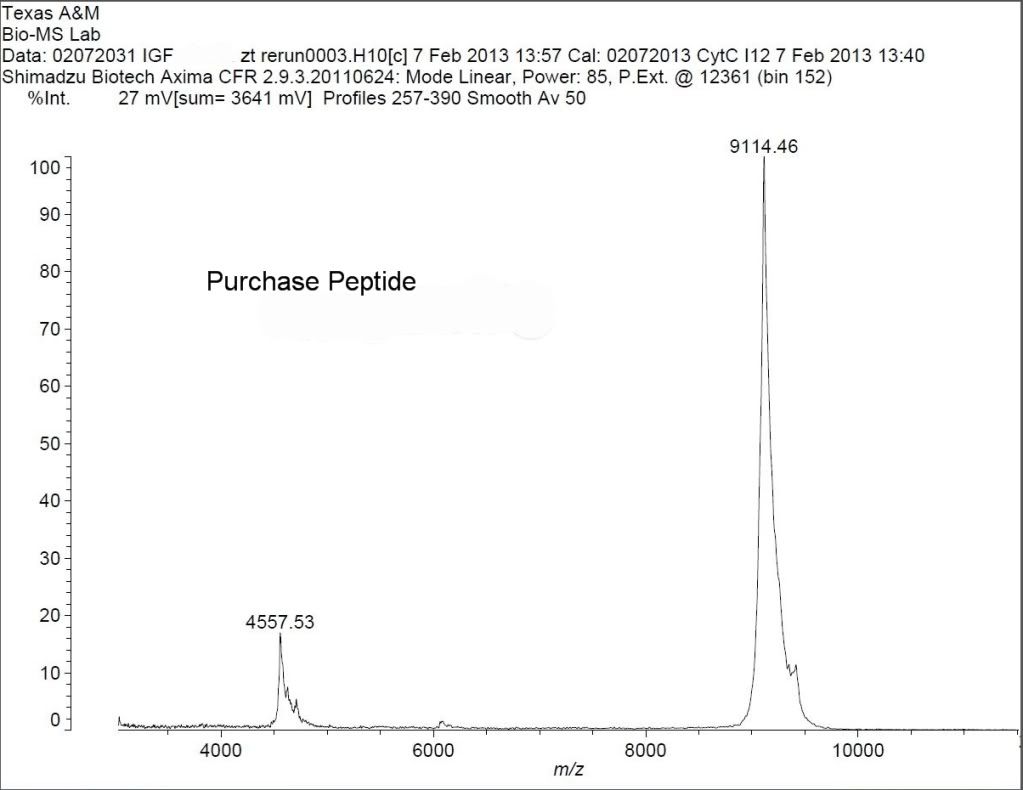
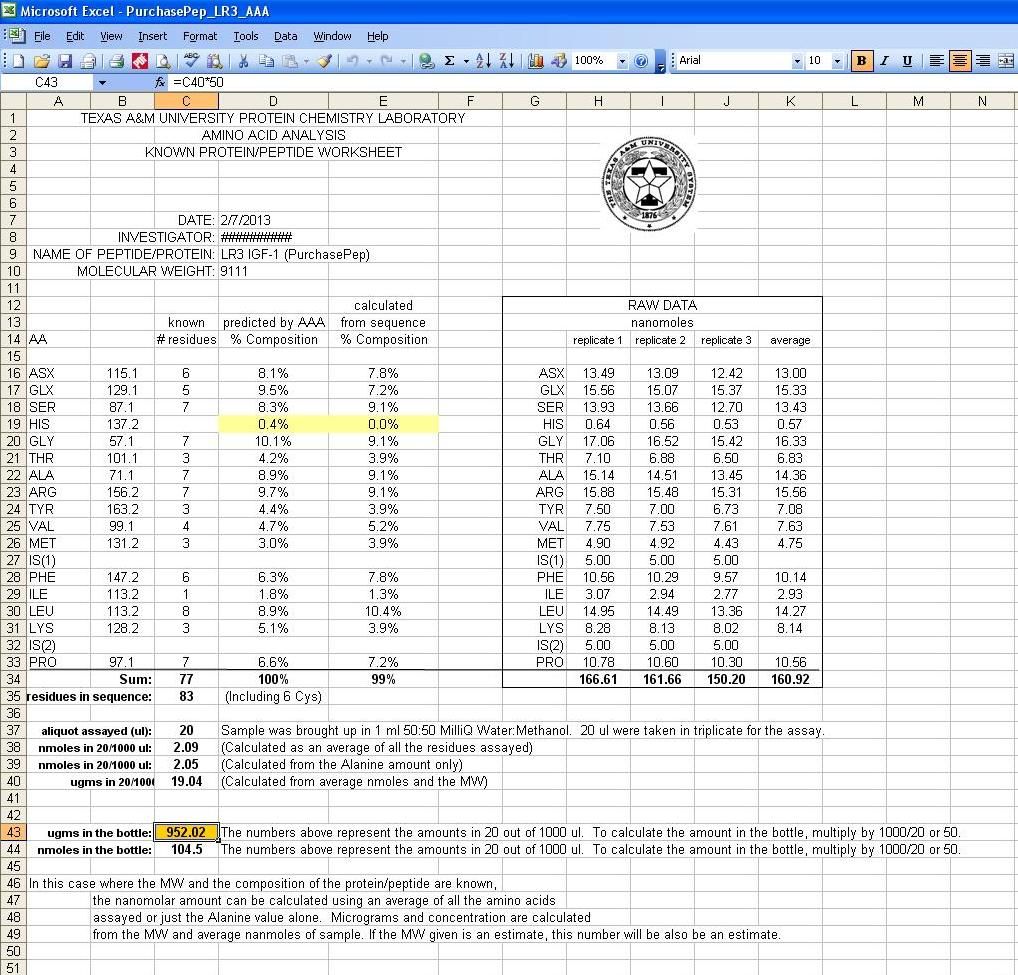
My thoughts:
First i am pretty impressed that we even had any damn LR3 in any of these vials cause i was very skeptical to begin with despite the source. I do not think any of them are "bad." I think it is matter of good or better. I have already contacted OstaPresident and sent him the raw data and have even offered to setup so he can send a vial directly to lab for analysis. I dont want anyone to think there are any fishy stuff going on.
SRC by pure analysis looks very good however the fact that they are the most expensive out of the bunch and had only 0.8mg which is about 20% short of advertised makes them great but very pricey. You pretty much have to add 20% to their price to get a real price on what 1.0mg would cost.
I think Extreme, Maxim and Purchase Peptide have a great product. We know for sure we have LR3 and pretty much as close as to 1.0mg as you can get. The histidine is very small when you look at % of amino acid involved. The lab tells me less then 5-8% may be His-tagged. So even if you subtract 8% from 0.95mg you still end up with more LR3 that is untagged and probably at a better price. It was revealed and confirmed by Extreme that Ergo's USA LR3 is the same as Extreme and they buy from exact same source so i did not want to spend another $400 to test the exact same product again since Extreme's tested so good.
Osta unfortunately had the peak at 7000 which neither lab or i can explain and had only 0.73mg of total protein in the vial. I am hoping they discuss this with their manufacturer and come back with a better batch to test or we can re-do the test if they would like.
Please do not turn this into mud slinging etc. The data is clear and evident. If you have direct questions about interpretations of the data etc please feel free to ask and i will respond.
At this point my job with LR3 is done. I think there are a lot of great options out there. I would like to turn my attention to DES. In my humble opinion, DES is even a better compound than LR3 but much more difficult to produce. We are completely out of funds for Des testing. If members would like to donate it would be great so we can do similar testing for DES. These tests normally cost $1000-1500 per sample but due to my pharma connections, the lab is doing it at cost which comes to ~400 when counting shipping. If members would like to donate please message me so i can send you paypal address so we can carry same testing with DES.
Several companies and members on PM donated funds and products to be tested. Maxim Peptides, Extreme, Purchase Peptides and Ergo were all willing and all donated funds for the cost of the testing to be done at a major university protein & chemistry lab. Every one of these companies donated funds and samples to be tested. Two companies that did not participate on their own but got their LR3 tested by donation of other members were Ostagain and SRC.
Osta particularly had a problem because they though somehow i would favor only Ergo due to me helping Phil cut through some of the BS some suppliers were giving him and trying to clean up his line up. SRC's LR3 was also tested but the company was not involved in the testing.
I have have said over and over again that my reputation and dignity means more than anything. There is nothing a peptide company can offer me to change my views on the truth. I told every sponsor that i will post exactly what is given to me by the lab and that there will be no sugar coating at all.
The testing was done by Texas A&M Protein and Chemistry lab and they are one of the premier labs for testing peptides in this country. I suggest you guys read the thread "Demand more from your sponsors" to understand the testing methods used.
Extreme Peptide LR3
To explain how to read each i am going to get a little nerdy. IGF LR3 has a mass weight of 9111 daltons. Assuming we could get a 100% pure peptide that was exactly we should get a very tall and narrow peak right at 9111 area. You can see from the MALDI-MASS that we have a very nice peak at the 9111 area but there is also another peak at the 9400 area. This is approximately a 3 amino acid difference in weight. You can see two smaller peaks in the 4000 range but small enough that really not a big deal. The sample is obviously not 100% pure LR3. The good new is that we do have a lot of protein at the 9111 area. So that is the MS.
Now the XL worksheet you see is the AAA (amino acid analysis) this is where the sample is actually broken down and we can see how many of each amino acid is present in a single chain. For example how many glutamine, how many leucine or valine etc. Since we know how many of each are SUPPOSED TO be in a real LR3 we can compare the PERCENTAGE of each known amino acid to be there vs what we actually get from sample tested. This is where it really things matter. That is because i can make a peptide long enough that weighs close to 9111 daltons and get a mass spec graph but it can be pure crap and have nothing to even do with IGF LR3. Hope this makes sense.
We can see from the XL worksheet that the sample was ran in a tripplicate assay for even better accuracy and the number of nanomoles of each amino acid in the chain.
Column C shows number of each amino acid that is supposed to be in a real LR3
Column D shows % of weight of each amino acid that is supposed to be in a real LR3
Column E shows % of weight of each amino acid that we actually got from sample being tested in this case Extreme's LR3
You can see that predicted vs what we got is very close and told by lab director completely within range of lab error and they include a 1.5% up or down either direction completely acceptable. So we can see that the Extremes sample had the right amount of each amino acid in the chain.
If you look at C:43 you can see that there was 989 micrograms of protein in total in the vial which means 0.98 mg which is 98% of 1mg. There was some Histidine amino acids in a very small amount found which LR3 should have no Histidine and lab director explained that this is most likely Histidine that is left over from the tagging process that may have not been cleaved off but extremely small which also is the cause of the 2nd spike we see on the MS graph at 9400 area.
Overall he felt very comfortable to say this is LR3


Ostagain, SRC, Maxim LR3
Analysis for Maxim, Osta and SRC were done and results posted on same spec sheet for direct comparison. And i can say that they all look pretty good. Some better than others but i will go thru that detail in a little bit. The Mass Spec on all three appear on a single sheet. Let me give everybody some further clarification on Mass Spec. This is not a quantitative test meaning the height of the curve means NOTHING as far as how much product is there. So if a peak is higher than another does not mean that there is more of that compound than one that has a smaller or taller peak. Hope that makes sense. Mass spec allows you to find how PURE your compound is and if there are other proteins with different target weights in the same sample.
All four LR3 tested have small peak in the 4500 range area. That is EXPECTED. MALDI TOF measures particles in single charged particles and since our target weight is 9111 daltons some couples charged particles will show up 9100/2= ~4500 range. The key factor is that if you had and could make a 100% pure LR3 you would have a single tall peak at 9111 and nothing else. We see that with SRC. There are no peaks anywhere else below or above 9111. With Osta's LR3 we see peaks 7000,9100 and 9400 range. The 9400 rang peak is similar to same 9400 peak as in Maxim (even though it looks taller it is meaningless) and Extreme that we tested last week. This is for sure from Histidine that was uncleaved in the final process. The % appears very small because the amino acid analysis looks good on all samples. The only issue that Ostas LR3 had that none of the other 3 had was that there was a peak at 7000. That is a compound that is not IGF-1, DES or LR3. So it is either degraded LR3 that has broken down to smaller weights but it is a little unlikely cause then we should have peaks in other places besides 7000. Maxim's mass spec looked very good same as Extreme we did last week. It has a nice peak at 9100 area and a tiny peak at 9400 due to histidine being attached that shows up in the amino acid analysis.

Now this is SRC's AAA: The percentages of each amino acid is within range and overall looks very good. This was the only sample that had 0.0% histidine. The only issue was that there was only approximately 0.8mg of product which is 20% short of advertised amount.

This is Osta's AAA. The amino acid percentages look spot on and had minor histidine like all the others. The only issue was that it had approx 0.73mg of total protein in the vial.

This is Maxim's AAA. It also looked very good with minimal Histidine attached and has 0.95mg of total protein attached. Both the Extreme and Maxim LR3 in analysis looked pretty identical. Phil mentioned under the IGF thread yesterday that his source is exact same and it is good to get confirmation through the lab on how close they were after MassSpec and amino acid analysis.

Purchase Peptides LR3
The results are nearly identical to Extreme, Maxim, and Ergo USA LR3. I would rate these 4 LR3 as excellent LR3. You can see in the mass spec that we have a nice tall peak at 9100 range with a tiny bump in the 9400 range which again is because of the tiny amount of histidine tag present. The rest of the mass spec looks very clean without any other impurities. The amino acid analysis also looks very good with total of 0.95mg of total LR3 in the vial which is pretty as much as good as it gets.


My thoughts:
First i am pretty impressed that we even had any damn LR3 in any of these vials cause i was very skeptical to begin with despite the source. I do not think any of them are "bad." I think it is matter of good or better. I have already contacted OstaPresident and sent him the raw data and have even offered to setup so he can send a vial directly to lab for analysis. I dont want anyone to think there are any fishy stuff going on.
SRC by pure analysis looks very good however the fact that they are the most expensive out of the bunch and had only 0.8mg which is about 20% short of advertised makes them great but very pricey. You pretty much have to add 20% to their price to get a real price on what 1.0mg would cost.
I think Extreme, Maxim and Purchase Peptide have a great product. We know for sure we have LR3 and pretty much as close as to 1.0mg as you can get. The histidine is very small when you look at % of amino acid involved. The lab tells me less then 5-8% may be His-tagged. So even if you subtract 8% from 0.95mg you still end up with more LR3 that is untagged and probably at a better price. It was revealed and confirmed by Extreme that Ergo's USA LR3 is the same as Extreme and they buy from exact same source so i did not want to spend another $400 to test the exact same product again since Extreme's tested so good.
Osta unfortunately had the peak at 7000 which neither lab or i can explain and had only 0.73mg of total protein in the vial. I am hoping they discuss this with their manufacturer and come back with a better batch to test or we can re-do the test if they would like.
Please do not turn this into mud slinging etc. The data is clear and evident. If you have direct questions about interpretations of the data etc please feel free to ask and i will respond.
At this point my job with LR3 is done. I think there are a lot of great options out there. I would like to turn my attention to DES. In my humble opinion, DES is even a better compound than LR3 but much more difficult to produce. We are completely out of funds for Des testing. If members would like to donate it would be great so we can do similar testing for DES. These tests normally cost $1000-1500 per sample but due to my pharma connections, the lab is doing it at cost which comes to ~400 when counting shipping. If members would like to donate please message me so i can send you paypal address so we can carry same testing with DES.

























